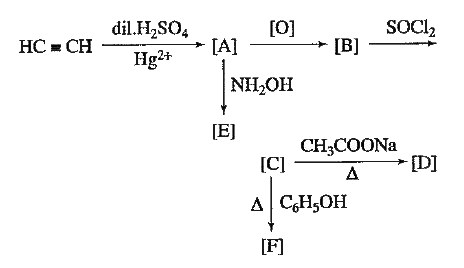When water is added to compound (A) of calcium, solution of compound (B) is formed. When carbon dioxide is passed into the solution, it turns milky due to the formation of compound (C). If excess of carbon dioxide is passed into the solution milkiness disappears due to the formation of compound (D). Identify the compounds A,B,C and D. Explain why the milkiness disppears in the last step.
To solve the problem, let's identify the compounds A, B, C, and D step by step, along with the reasoning behind each identification.
Step 1: Identify Compound A
When water is added to compound A, a solution of compound B is formed. Since we are dealing with calcium compounds, we can consider calcium oxide (CaO) as compound A.
Reaction:
CaO+H2O→Ca(OH)2
Step 2: Identify Compound B
The solution formed from compound A when water is added is calcium hydroxide, which is commonly known as lime water. Therefore, compound B is calcium hydroxide (Ca(OH)₂).
Step 3: Identify Compound C
When carbon dioxide (CO₂) is passed into the solution of compound B (calcium hydroxide), it reacts to form calcium carbonate (CaCO₃), which is responsible for the milkiness observed in the solution.
Reaction:
Ca(OH)2+CO2→CaCO3+H2O
Thus, compound C is calcium carbonate (CaCO₃).
Step 4: Identify Compound D
When excess carbon dioxide is passed into the solution, the milkiness disappears. This occurs because calcium carbonate reacts with the excess carbon dioxide to form calcium hydrogen carbonate (Ca(HCO₃)₂), which is soluble in water and does not produce a milky solution.
Reaction:
CaCO3+CO2+H2O→Ca(HCO3)2
Thus, compound D is calcium hydrogen carbonate (Ca(HCO₃)₂).
Summary of Compounds
- Compound A: Calcium oxide (CaO)
- Compound B: Calcium hydroxide (Ca(OH)₂)
- Compound C: Calcium carbonate (CaCO₃)
- Compound D: Calcium hydrogen carbonate (Ca(HCO₃)₂)
Explanation of Milkiness Disappearance
The milkiness disappears when excess carbon dioxide is passed into the solution because calcium carbonate, which is insoluble and causes the milky appearance, reacts with the carbon dioxide and water to form calcium hydrogen carbonate, which is soluble in water. This reaction effectively removes the solid calcium carbonate from the solution, resulting in a clear solution.
When water is added to compound A, a solution of compound B is formed. Since we are dealing with calcium compounds, we can consider calcium oxide (CaO) as compound A.
CaO+H2O→Ca(OH)2
The solution formed from compound A when water is added is calcium hydroxide, which is commonly known as lime water. Therefore, compound B is calcium hydroxide (Ca(OH)₂).
When carbon dioxide (CO₂) is passed into the solution of compound B (calcium hydroxide), it reacts to form calcium carbonate (CaCO₃), which is responsible for the milkiness observed in the solution.
Ca(OH)2+CO2→CaCO3+H2O
When excess carbon dioxide is passed into the solution, the milkiness disappears. This occurs because calcium carbonate reacts with the excess carbon dioxide to form calcium hydrogen carbonate (Ca(HCO₃)₂), which is soluble in water and does not produce a milky solution.
CaCO3+CO2+H2O→Ca(HCO3)2
- Compound A: Calcium oxide (CaO)
- Compound B: Calcium hydroxide (Ca(OH)₂)
- Compound C: Calcium carbonate (CaCO₃)
- Compound D: Calcium hydrogen carbonate (Ca(HCO₃)₂)
The milkiness disappears when excess carbon dioxide is passed into the solution because calcium carbonate, which is insoluble and causes the milky appearance, reacts with the carbon dioxide and water to form calcium hydrogen carbonate, which is soluble in water. This reaction effectively removes the solid calcium carbonate from the solution, resulting in a clear solution.
Topper's Solved these Questions
- THE S-BLOCK ELEMENTS BOOK - NCERT EXEMPLAR ENGLISHCHAPTER - THE S-BLOCK ELEMENTS EXERCISE - Assertion and Reason
2 Videos
- THE P-BLOCK ELEMENTSBOOK - NCERT EXEMPLAR ENGLISHCHAPTER - THE P-BLOCK ELEMENTSEXERCISE - Long Answer
9 Videos
- THERMODYNAMICSBOOK - NCERT EXEMPLAR ENGLISHCHAPTER - THERMODYNAMICSEXERCISE - Multiple choice questions
62 Videos
Similar Questions
Knowledge Check
When CO2 is passed through lime water , the milkiness first formed is due to the formation of ………………….
Athe reversible reaction taking placeBformation of water soluble calcium bicarbonateChuge amount of heat evolved during the reactionDformation of water soluble complex of calciumWhen carbon dioxide binds to haemoglobin, which of the following compounds is formed?
ACarbonic acidBHydrogencarbonate ionsCOxyhaemoglobinDCarbaminohaemoglobin
Why is solution of potassium hydroxide used to absorb carbon dioxide evolved during the estimation of carbon present in an organic compound?
View SolutionWhen chlorine is passed through concentrated solution of KOH, the compound formed is ____________ .
View SolutionWhen a reagent (X) reacts with Fe3+ salt solution turnsred due to the formation of a compound (Y). This reagent cause no change in colour with Fe2+ salt solution. Compound (X) and (Y) are respectively:
View SolutionIdentify (A) to (C).
(a) An inorganic iodide (A) on heating with a solution of KOH gives a gas (B) and the solution of a compound (C).
View SolutionWhen a brown compound of manganese (A) is treated with HCl it gives a gas (B). The gas taken in excess, reacts with NH3 to give an explosive compound (C ). Identify compound A, B and C.
View SolutionIdentify the anion present in the following compound : When a solution of compound Y is treated with silver nitrate solution a white precipitate is obtained which is soluble in excess of ammonium hydroxide solution.
View Solution

